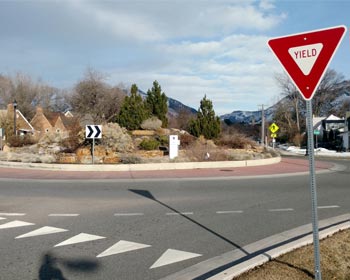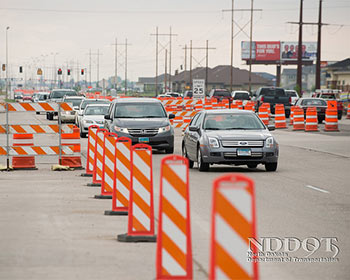MPC-Funded Research Published
Posted: Mar 2, 2021
Several papers from MPC-funded research projects were recently published. They include the following:
 "Bicycle safety at roundabouts: a systemic literature review" was written by Niranjan Pudel and Patrick Singleton with the Department of Civil and Environmental Engineering at Utah State University. The article was recently published in the journal Transport Reviews. Roundabout safety for people bicycling is of major concern. The researchers reviewed 49 different resources with empirical findings from Europe, Australia, New Zealand and the United States. Consistent with design guidance, bicycle safety performance is worse for higher-speed, multilane roundabouts and when on-roadway bike lanes are provided. Crash data and observations suggest that when cyclists "take the lane" and operate as vehicles – as is allowed or even recommended in some current design guidelines – it can lead to conflicts and crashes between circulating cyclists and entering drivers who may have "looked but failed to see" (and thus failed to yield to) the cyclist. Providing separated cycle paths around the roundabout seems to be a lower-risk and more comfortable design solution. Future research should investigate more design features, socio-demographic characteristics, and cyclist safety perceptions.
"Bicycle safety at roundabouts: a systemic literature review" was written by Niranjan Pudel and Patrick Singleton with the Department of Civil and Environmental Engineering at Utah State University. The article was recently published in the journal Transport Reviews. Roundabout safety for people bicycling is of major concern. The researchers reviewed 49 different resources with empirical findings from Europe, Australia, New Zealand and the United States. Consistent with design guidance, bicycle safety performance is worse for higher-speed, multilane roundabouts and when on-roadway bike lanes are provided. Crash data and observations suggest that when cyclists "take the lane" and operate as vehicles – as is allowed or even recommended in some current design guidelines – it can lead to conflicts and crashes between circulating cyclists and entering drivers who may have "looked but failed to see" (and thus failed to yield to) the cyclist. Providing separated cycle paths around the roundabout seems to be a lower-risk and more comfortable design solution. Future research should investigate more design features, socio-demographic characteristics, and cyclist safety perceptions.
The article was published as part of the research for MPC project 603, "Investigating Bicyclist Safety Perceptions and Behaviors at Roundabouts."
 "Effect of tack coat emulsion type, application rate, and surface type and texture on early-age interlayer shear strength of pavements in cold regions" was recently published in the International Journal of Pavement Engineering. The article was written by Rouzbeh Ghabchi and Chamikia Dharmarathna with the Department of Civil and Environmental Engineering at South Dakota State University. Asphalt pavement is a multilayered structure designed to perform as a single unit. Tack coat is an asphaltic material applied between an asphalt pavement layer and an existing pavement surface to improve interlayer bond. Inadequate bond due to application of insufficient or excessive amounts of tack coat may lead to poor structural behavior. The researchers investigated the effectiveness of different types of tack coats in improving the early-age interlayer shear strength of asphalt pavements constructed on different surface types. They also studied the effects of other parameters, such as tack coat type, application rate, moisture and freeze-thaw cycle, and surface texture on interlayer shear strength.
"Effect of tack coat emulsion type, application rate, and surface type and texture on early-age interlayer shear strength of pavements in cold regions" was recently published in the International Journal of Pavement Engineering. The article was written by Rouzbeh Ghabchi and Chamikia Dharmarathna with the Department of Civil and Environmental Engineering at South Dakota State University. Asphalt pavement is a multilayered structure designed to perform as a single unit. Tack coat is an asphaltic material applied between an asphalt pavement layer and an existing pavement surface to improve interlayer bond. Inadequate bond due to application of insufficient or excessive amounts of tack coat may lead to poor structural behavior. The researchers investigated the effectiveness of different types of tack coats in improving the early-age interlayer shear strength of asphalt pavements constructed on different surface types. They also studied the effects of other parameters, such as tack coat type, application rate, moisture and freeze-thaw cycle, and surface texture on interlayer shear strength.
The research was conducted as part of MPC project 522, "Development of a Guideline for Selection of Tack Coats in South Dakota."
 "Study of work zone traffic safety under adverse driving conditions with a microscopic traffic simulation approach" was recently published in the journal, Accident Analysis and Prevention. The article was written by Guangyang Hou and Suren Chen with the Department of Civil and Environmental Engineering at Colorado State University. Existing studies on work zone traffic safety with statistical approaches are limited by the availability of data from historical crashes. To date, there is no comprehensive simulation framework to assess work zone traffic safety under adverse driving environments by considering both multi-vehicle and single-vehicle crashes. The researchers present an integrated framework to evaluate traffic safety in work zones under adverse driving conditions by considering specific work zone configuration, weather, and road surface conditions. A new risk index is introduced to assess the traffic safety risk of work zones by integrating the risks of multi-vehicle crashes and single-vehicle crashes.
"Study of work zone traffic safety under adverse driving conditions with a microscopic traffic simulation approach" was recently published in the journal, Accident Analysis and Prevention. The article was written by Guangyang Hou and Suren Chen with the Department of Civil and Environmental Engineering at Colorado State University. Existing studies on work zone traffic safety with statistical approaches are limited by the availability of data from historical crashes. To date, there is no comprehensive simulation framework to assess work zone traffic safety under adverse driving environments by considering both multi-vehicle and single-vehicle crashes. The researchers present an integrated framework to evaluate traffic safety in work zones under adverse driving conditions by considering specific work zone configuration, weather, and road surface conditions. A new risk index is introduced to assess the traffic safety risk of work zones by integrating the risks of multi-vehicle crashes and single-vehicle crashes.
The research was conducted as part of MPC Project 591, "Reliability-Based Traffic Safety Risk Assessment of Traffic Systems in Hazardous Driving Conditions to Promote Community Resilience."